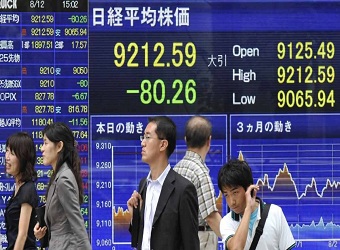Stocks in Asia were mixed on Thursday following the release of Caixin PMI data from China, which was at an 11-month low and as the yuan hit a seven-month high.
The on-shore yuan traded at 6.7894 to the dollar at 12:29 p.m. HK/SIN, at levels not seen since last November. Before markets opened in China, the People’s Bank of China set the yuan mid-point at 6.8090 to the dollar- its strongest level in seven months according to Reuters.
China’s central bank lets the yuan spot rate rise or fall a maximum of 2 percent against the greenback, relative to the official fixing rate.
In the offshore market, where the yuan is more freely traded, the currency fetched 6.7309 to the dollar.
“While there remains some politics in play after the Moody’s downgrade, with numerous projects recently tabled through the ‘One Belt, One Road’ initiative, the stronger yuan could be in China’s best interest to promote yuan internationalization and attract more investment,” OANDA Senior Trader Stephen Innes said in a note.
Japan’s benchmark Nikkei 225 index jumped 1.1 percent, while the Kospi reversed earlier gains to trade lower by 0.15 percent.
Down Under, the S&P/ASX 200 was mostly steady, trading higher by 0.11 percent.
Markets in greater China were mixed. The Hang Seng Index was higher by 0.35 percent. The Shanghai Composite was down 0.51 percent while the Shenzhen Composite fell 0.973 percent.
This followed the release of Caixin manufacturing PMI figures for China in the month of May. The data showed factory activity fell to an 11 month low, coming in at 49.6 compared to the 50.1 forecast.
The latest Caixin PMI read weighed on the Australian dollar, which fetched as high as $0.7454 earlier on the back of domestic retail sales figures. The Aussie traded at $0.7398 at 12:25 p.m. HK/SIN.
“Today’s data is a reminder of what is important for Australia — and it’s that a soft China overrides positive domestic data for Australia, as this feeds back into their own growth and inflationary projects,” ThinkMarkets Senior Market Analyst Matt Simpson said.
“Whichever (way) you spin it, the Aussie is not in for a good session from here.”
Indonesian markets were closed for a public holiday.
The start of the new month will also bring with it a fair amount of risk for markets to navigate, IG Strategist Chris Weston said in a note.
“There will be a reasonable amount of event risk to work through, not just with U.K. elections (June 8), with the ramifications of that event seemingly contained to U.K. assets, but key central bank meetings from the European Central Bank (also June 8) and Federal Reserve (June 14),” Weston said.
“Of course, we will keep a focus on all things Trump too, and his approval rating, given the dollar’s correlation there.”
Meanwhile, annual economic growth figures in India slowed in the quarter ended March, coming in at 6.1 percent. The weaker than expected figures released yesterday reflected the lagged impact of demonetization, Goldman Sachs said in an early morning note, adding that economic growth for the year remained in line with expectations.
Oil prices gained after falling 3 percent in the last session. U.S. crude jumped 0.99 percent to trade at $48.80 a barrel while Brent crude gained 0.91 percent at $51.22.
Against a basket of six major currencies, the dollar traded at 96.972, softer than levels around the 97 handle seen last week.
The dollar was mostly steady against the yen. At 12:25 p.m. HK/SIN, the greenback fetched 110.94 yen, lower than the 111 handle seen last week but off lows of 110.65 seen in the overnight session.
Meanwhile, the British pound recovered slightly after falling to a one-month low earlier in the week. The pound last traded at $1.2872.
Stateside, stocks closed slightly lower due to soft performance from financials and concerns over inflation after the Fed’s Beige Book was released. Following the release of the Beige Book on Wednesday, the 10-year Treasury yield at one pointdipped below 2.2 percent mark.
Key U.S. economic data is expected after Asian trading hours, with the ADP employment report, ISM manufacturing PMI and auto sales for the month of May due later in the day.
Source: CNBC


